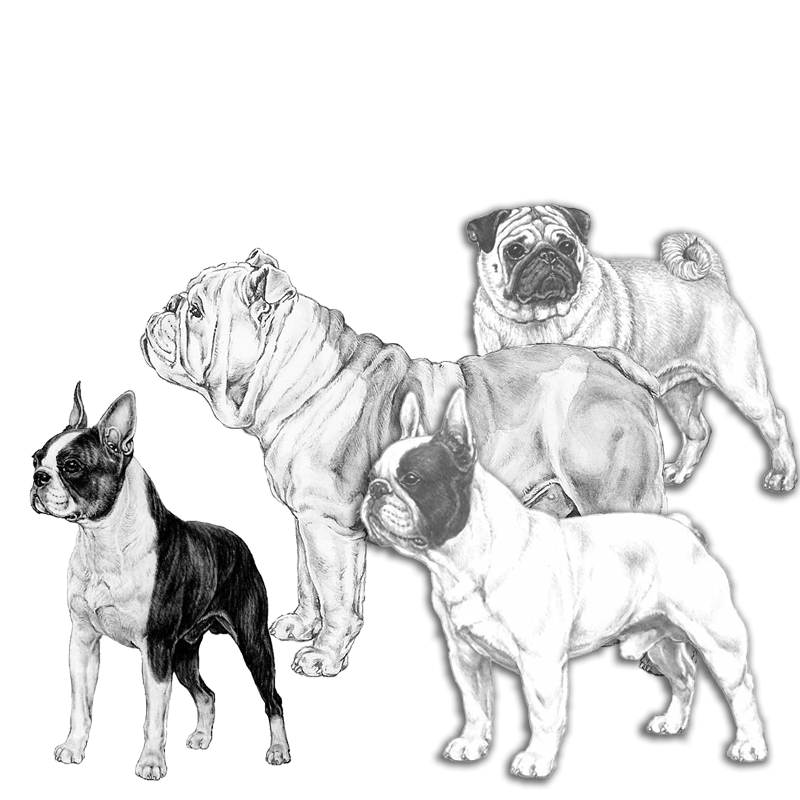There is a steady stream of articles / work / initiatives coming in relative to those brachy breeds identified as highest risk for health and welfare issues. Coming from KCs - e.g. SKK...

(See the background of and supportive documentation for this NKU project below...)
the Mops Club, Netherlands... 
See the recent discussion of main features of the BALV (outcross, approval and stricter breeding rules) and communication with government and other KC's...
and from the veterinary sector ... e.g. FECAVA...
‘Extreme breeding’ of companion animals: Raising public awareness is key
In general, the work is based on scientific evidence. Of course, some of the initiatives (measurements etc) are 'new' and not yet fully proven in efficacy for what is proposed.
Regardless of the basis, these proposal evoke extreme emotional and even personal responses (e.g. FB, confrontations and disagreements, etc.).
FB, confrontations and disagreements, etc.).
Because... at heart these issues relate to a seemingly widespread human attraction to 'extremes'.
We are happy to also present excellent articles on avoidance of extremes in other breeds - e.g. Dachshunds and Rottweilers.
Clearly, we need not only an evidence-based approach to deal with these issues, but also innovative communication strategies to effect change in human behaviours and attitudes.
Brachycephalic projects by the Nordic Kennel Union's affiliated Kennel Clubs is available at:
Of particular interest are project planning documents put together by the NKU's Working group and SKK. These documents outline health and welfare issues and offer proposed actions, definitions, parameters and procedures for evaluation of dogs.
Internal link: NKU STATEMENTS AND PROPOSALS REGARDING RESPIRATORY HEALTH IN BRACHYCEPHALIC DOGS.pdf
ADDITIONAL INFO...
2. REVEALING THE PHENOTYPIC AND GENOTYPIC VARIATION IN FOUR BRACHYCEPHALIC BREEDS (SKK)
As part of the work to combat breathing problems in brakycephalics, the Swedish Kennel Club has started a project to inventory the health status in four dog breeds: Boston Terrier, English Bulldog, French Bulldog and Pug.
excerpts...
Quote
AIMS
1. To reveal if there is sufficient phenotypic and genotypic variation in four brachycephalic breeds to allow selection to achieve a change in anatomy to reduce the predisposition for Brachycephalic Obstructive Airway Syndrome (BOAS)
2. To indicate breeding animals that by fitness and morphological features would enhance the health in these breeds.
3. To relate phenotypic measures to underlying genetic factors
MATERIALS AND METHODS
The project is based on “Breed” - gatherings - arranged for by the breed clubs – and supported by the national Kennel Clubs
At 2-4 gatherings per breed and country and as many individuals as possible in these breeds are aimed to reach at various locations in Denmark, Finland, Norway and Sweden. These breed gatherings are aimed to attract registered as well as non-registered individuals nationally and internationally obtained to reflect the within breed variations.
One to three show judges (or with comparable competence) and 1-3 veterinarians are to be recruited to perform the phenotypic description of each participating dog. Students and breed club members are recruited to assist in measurements and documentation. A form for reporting and a form to be handed out will be developed.
It is essential that the event is meant to describe and not to rank the participating dogs.
It is however crucial to plan for how to best inform and advice the owner if their dog is evaluated to suffer from BOAS.
Information to be gathered
1. data by breed on
a) Demography: gender, age, country of origin, registration number or not
b) Measures of weight, BodyConditionScore (BCS) and conformational measurements (i.e. width of Nares (WN), craniofacial ratio (CFR), neck girth ratio (NGR).
c) Photo in standardised position (whole body and Skull)
c) General and specific health conditions by surveying owners
d) A veterinary examination (clinical data including BOAS)c) and d) will follow the procedure at the examination of adult dogs for BOAS except/ before the provocation by exercise (link to the form with instructions)
2. samples for genomic analysesCheek swabs will be obtained from each dog for molecular genetic studies
a) SNP-array genotyping of around 400 dogs as described above
a) By analyses of data it is intended to compare variations within and between breeds for age, gender, origin and the indicated measures – Body weight, Body Condition Score (BCS) and conformational measurements (i.e. width of Nares (WN), craniofacial ratio (CFR), neck girth ratio (NGR).
to relate it to clinical data and the data from the molecular genetic studiesb) By indication of favourable phenotypes and genotypes it is intended to influence the selection of breeding stock in these breeds
The full document "REVEALING THE PHENOTYPIC AND GENOTYPIC VARIATION IN FOUR BRACHYCEPHALIC BREEDS (SKK)" is available. Contact us.
♦ All these topics - extremes, breed and communication will be a focus in the 4th IDHW.... ♦
 Donate
Donate

Recommended Comments
There are no comments to display.
Join the conversation
You can post now and register later. If you have an account, sign in now to post with your account.
Note: Your post will require moderator approval before it will be visible.